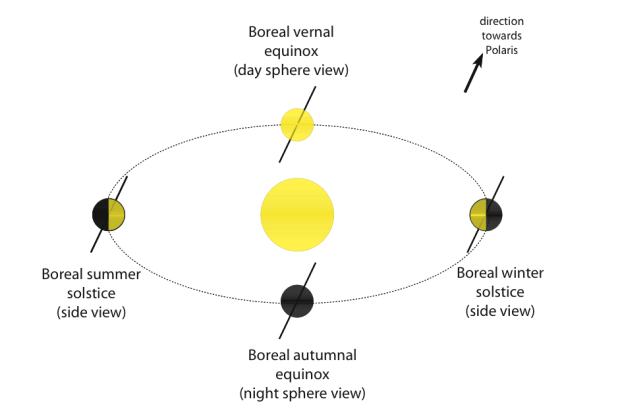Posts Tagged seasons
HIPPARCHUS (c.190 – c.125 BCE)
Posted by historyofscience101 in ASTROLOGY, ASTRONOMY, GREEK PHILOSOPHY, HISTORY OF SCIENCE, MATHS, THE STARS on December 22, 2013
134 BCE – Nicaea, Turkey
Observation of a new star in the constellation Scorpio
The ‘Precession of the Equinoxes’
By the time Hipparchus was born, astronomy was already an ancient art.
Hipparchus plotted a catalogue of the stars – despite warnings that he was thus guilty of impiety. Comparing his observations with earlier recordings from Babylonia he noted that the celestial pole changed over time.
He speculated that the stars are not fixed as had previously been thought and recorded the positions of 850 stars.
Hipparchus‘ astronomical calculations enabled him to plot the ecliptic, which is the path of the Sun through the sky. The ecliptic is at an angle to the Earth‘s equator, and crosses it at two points, the equinoxes (the astronomical event when the Sun is at zenith over the equator, marking the two occasions during the year when both hemispheres are at right angles to the Sun and day and night are of equal length).
The extreme positions of summer and winter mark the times in the Earth’s orbit where one of the hemispheres is directed towards or away from the Sun.
Solstice
The Sun is furthest away at the solstices.
From his observations, he was able to make calculations on the length of the year.
There are several ways of measuring a year astronomically and Hipparchus measured the ‘tropical year’, the time between equinoxes.
Hipparchus puzzled that even though the Sun apparently traveled a circular path, the seasons – the time between the solstices and equinoxes – were not of equal length. Intrigued, he worked out a method of calculating the Sun’s path that would show its exact location on any date.
To facilitate his celestial observations he developed an early version of trigonometry. With no notion of sine, he developed a table of chords which calculated the relationship between the length of a line joining two points on a circle and the corresponding angle at the centre.
By comparing his observations with those noted by Timocharis of Alexandria a century and a half previously, Hipparchus noted that the points at which the equinox occurred seemed to move slowly but consistently from east to west against the backdrop of fixed stars.
We now know that this phenomenon is not caused by a shift in the stars.
Because of gravitational effects, over time the axis through the geographic North and South poles of the Earth points towards different parts of space and of the night sky.
The Earth’s rotation experiences movement caused by a slow change in the direction of the planet’s tilt; the axis of the Earth ‘wobbles’, or traces out a cone, changing the Earth’s orientation as it orbits the Sun.
The shift in the orbital position of the equinoxes relative to the Sun and the change in the seasons is now known as ‘the precession of the equinoxes’, but Hipparchus was basically right.
Hipparchus‘ only large error was to assume, like all those of his time except ARISTARCHUS that the Earth is stationary and that the Sun, moon, planets and stars revolve around it. The fact that the stars are fixed and the Earth is moving makes such a tiny difference to the way the Sun, moon and stars appear to move that Hipparchus was still able to make highly accurate calculations.
These explanations may show how many people become confused by claims that the Earth remains stationary as was believed by the ancients – from our point-of-view on Earth that IS how things could appear.
a) demonstration of precession.
https://www.youtube.com/watch?v=qlVgEoZDjok (copyright)
https://www.youtube.com/watch?v=q4_-R1vnJyw&w=420&h=315
Because the Babylonians kept records dating back millennia, the Greeks were able to formulate their ideas of the truth.
He gave a value for the annual precession of around 46 seconds of arc (compared to a modern figure of 50.26 seconds). He concluded that the whole star pattern was moving slowly eastwards and that it would revolve once every 26,000 years.
Hipparchus also made observations and calculations to determine the orbit of the moon, the dates of eclipses and devised the scale of magnitude or brightness that, considerably amended, is still in use.
PTOLEMY cited Hipparchus as his most important predecessor.
Related sites
- From Hipparchus to Hipparcos (wwwhip.obspm.fr/)
- Hipparchus of Rhodes (history.mcs.st-andrews.ac.uk/Biographies/)
- Greek Astronomy (quantumredpill.wordpress.com)



 NEXT
NEXT